Dijon
|
Dijon |
|
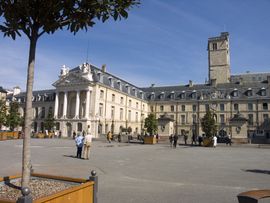 |
|
| Palais Duc Bourgogne | |
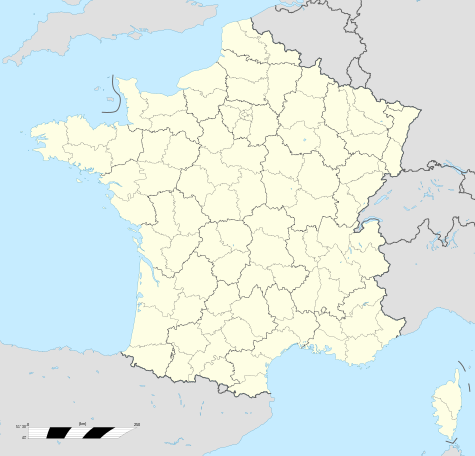 Dijon
|
|
|
Location within Burgundy region
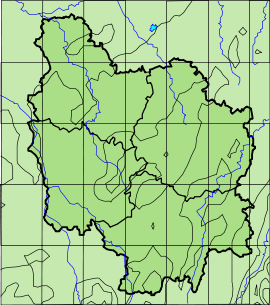 Dijon
|
|
| Administration | |
|---|---|
| Country | France |
| Region | Burgundy |
| Department | Côte-d'Or |
| Arrondissement | Dijon |
| Intercommunality | Dijon |
| Mayor | François Rebsamen (PS) (2001–2014) |
| Statistics | |
| Elevation | 220–410 m (720–1,350 ft) (avg. 245 m/804 ft) |
| Land area1 | 40.41 km2 (15.60 sq mi) |
| Population2 | 155,387 (2007[1]) |
| - Density | 3,845 /km2 (9,960 /sq mi) |
| INSEE/Postal code | 21231/ 21000 |
| Website | http://www.dijon.fr/ |
| 1 French Land Register data, which excludes lakes, ponds, glaciers > 1 km² (0.386 sq mi or 247 acres) and river estuaries. | |
| 2 Population sans doubles comptes: residents of multiple communes (e.g., students and military personnel) only counted once. | |
Dijon (French pronunciation: [diʒɔ̃] (![]() listen)) is a city in eastern France, the capital of the Côte-d'Or département and of the Burgundy region. Dijon is the historical capital of the province of Burgundy. Population (2005): 150,800 within the city limits; 236,953 for the greater Dijon area.
listen)) is a city in eastern France, the capital of the Côte-d'Or département and of the Burgundy region. Dijon is the historical capital of the province of Burgundy. Population (2005): 150,800 within the city limits; 236,953 for the greater Dijon area.
Contents |
History
Dijon began as a Roman settlement called Divio, located on the road from Lyon to Paris. Saint Benignus, the city's patron saint, is said to have introduced Christianity to the area before being martyred. This province was home to the Dukes of Burgundy from the early 11th until the late 15th centuries and Dijon was a place of tremendous wealth and power and one of the great European centres of art, learning and science. It was occupied by Nazi Germany between June 1940 and 11 September 1944, when it was liberated by joint French/UK/U.S. forces.[2]
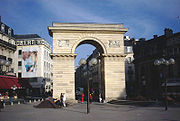
Main sights
Dijon boasts a large number of churches, notably Notre Dame de Dijon, St. Philibert, St. Michel and Dijon Cathedral, the crypt of which, dedicated to Saint Benignus, dates from 1,000 years ago. The city has retained varied architectural styles from many of the main periods of the past millennium, including Capetian, Gothic and Renaissance. Many still-inhabited town houses in the city's central district date from the 18th century and earlier.
Dijon architecture is distinguished by, among other things, toits bourguignons (Burgundian roofs) made of tiles glazed in terracotta, green, yellow and black and arranged in eye-catching geometric patterns.
Dijon was largely spared the destruction of wars such as the 1870 Franco-Prussian War and WWII, despite the city being occupied. Therefore, many of the old buildings such as the half-timbered houses dating from the 12th to the 15th centuries (found mainly in the city's core district) are undamaged, at least by organized violence.
Dijon is home to many museums, including the Musée des Beaux-Arts de Dijon in part of the Ducal Palace (see below). It contains, among other things, ducal kitchens dating back to the mid-15th century, and a substantial collection of European painting from Roman times through contemporary art.
Among the more popular sights is the Ducal Palace, the Palais des Ducs et des États de Bourgogne or "Palace of the Dukes and the States of Burgundy" (), which includes one of only a few remaining examples of the Capetian period in the region.
The church of Notre Dame is famous for both its art and architecture. Popular legend has it that one of its stone relief sculptures, an owl (la chouette) is a good-luck charm: visitors to the church touch the owl with their left hands to make a wish. (The current carving is a copy, as the original was damaged by vandalism in 2001).
Transport

Dijon is located approximately 300 km (190 mi) southeast of Paris, which takes about three hours by car along the motorways A38 and A6. The A31 provides connections to Nancy, Lille and Lyon. The A39 connects Dijon with Bourg-en-Bresse and Geneva, the A36 with Mulhouse and Basel.
The Gare de Dijon-Ville is the main railway station, providing connection in one hour and 40 minutes by the TGV high-speed train (LGV Sud-Est) to Paris-Gare de Lyon. For comparison, Lyon is 180 km (110 mi) away and two hours distant - although there is no high-speed train link between both cities. Nice takes about six hours by TGV and Strasbourg about three hours at regular train speed. Lausanne in Switzerland is less than 150 km (93 mi) away or two hours by train. Several regional trains of TER Bourgogne depart from the station.
A new tram network is under construction in Dijon; it is expected to open in 2013.[3]
Culture
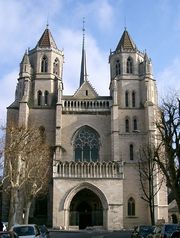
Dijon holds its International and Gastronomic Fair every year in autumn. With over 500 exhibitors and 200,000 visitors every year, it is one of the ten most important fairs in France. Dijon is also home, every three years, to the international flower show Florissimo.
To the northwest of Dijon, the race track of Dijon-Prenois hosts various motor sport events. It hosted the Formula 1 French Grand Prix on five occasions from 1974 to 1984.
Dijon is home to Dijon FCO, a soccer team in Ligue 2, the second-highest league in French football. Dijon is better known for its national professional league basketball club (Pro A), JDA Dijon.
Dijon has numerous museums such as the Musée des Beaux-Arts de Dijon, the Musée Archéologique, the Musée de la Vie Bourguignonne, the Musée d'Art Sacré, and the Musée Magnin. It also contains approximately 700 hectares of parks and green space, including the Jardin botanique de l'Arquebuse.
Apart from the numerous bars, which sometimes have live bands, some popular music venues in Dijon are : Le zenith de Dijon, La Vapeur and l'Atheneum.
Colleges and universities
- Dijon hosts the main campus of the University of Burgundy (Université de Bourgogne) [1]
- École nationale des beaux-arts de Dijon
- 1er cycle européen (Europe Centrale et Orientale) de Sciences Po Paris [2]
- ENESAD - Établissement National d’Enseignement Supérieur Agronomique de Dijon [3]
Food and drink
Mustard
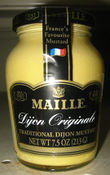
Dijon is famous for its mustard: the term Dijon mustard (moutarde de Dijon) designates a method of making a particularly strong mustard relish. This is not necessarily produced near Dijon, as the term is regarded as genericized under European Union law, so that it cannot be registered for protected designation of origin status.[4] Most Dijon mustard (brands such as Amora or Maille) is produced industrially and over 90% of mustard seed used in local production is imported, mainly from Canada. In 2008, Unilever closed its Amora mustard factory in Dijon. Dijon mustard shops also feature exotic or unusually-flavored mustard (fruit-flavoured, for example), often sold in decorative hand-painted faience (china) pots.
Wine and Liqueurs
As the capital of the Burgundy region, Dijon reigns over some of the best wine country in the world. Many superb vineyards producing vins d'appellation contrôlée, such as Vosne-Romanée and Gevrey-Chambertin, are within 20 minutes of the city center. The town's university boasts a renowned oenology institute. The road from Santenay to Dijon, known as the route des Grands Crus, passes through an idyllic countryside of vineyards, rivers, villages, forests, and 12th century churches.
The city is also well known for its crème de cassis, or blackcurrant liqueur, used in the drink known as "Kir", a mixture of white wine, especially Bourgogne aligoté, with blackcurrant liqueur, named after former mayor of Dijon canon Félix Kir.
Cuisine
Dijon is home to some of the finest French cuisine. Well-known regional dishes include Beef bourguignon, Coq au vin, Escargot, Gougère and pain d'épices (the local form of gingerbread).
The tradition of pain d'épices de Dijon dates to the 14th century. Today it is predominantly made of rye flour and honey, with the addition of spices such as clove, ginger, cinnamon and sometimes anise. It is often garnished with candied fruits.[5] The recipe is recognizably similar to what is called gingerbread in England, though the term pain d'épices is sometimes used in English to make the distinction. Modern commercial Dijon recipes are generally quite different from the harder gingerbreads that are sold as carnival food in Germany.
The American food writer M.F.K. Fisher, who moved to France in 1929 shortly after her marriage, wrote about the region's cuisine and her experience living in Dijon in Long Ago in France.
Notable people
.svg.png)
- John the Fearless (1371–1419), Duke of Burgundy
- Charles, Duke of Burgundy (1433–1477)
- Jane Frances de Chantal (Jeanne - Françoise Frémiot, baronne de Chantal, 1572–1641), founder of the Visitation Order
- Jacques-Bénigne Bossuet (1627–1704), bishop and theologist
- Jean-Philippe Rameau (1683–1764), composer
- Bernard Courtois (1777–1838), discoverer of the element iodine
- François Rude (1784–1855), sculptor
- Augustin Cauchy (1789–1867), mathematician
- Henry Darcy (1803–1858), engineer
- François Jouffroy (1806–1882), sculptor
- Alexandre Gustave Eiffel (1832–1923), engineer and architect
- Elizabeth of the Trinity (Marie - Élisabeth Catez, 1880–1906), Carmelite nun and religious writer
- Roger Guillemin (b. 1924), Nobel laurate in Physiology and Medicine
- Jean-Pierre Marielle (b. 1932), actor
- Claude Jade (1948–2006), actress
- Vitalic (born as Pascal Arbez in 1976), an electronic music artist.
- Julien Pillet (b. 1977), olympic medalist sabre fencer
- Madjid Bougherra (b. 1982), Rangers F.C. football/soccer player.
- Laurent Chambertin volleyball player
Photo gallery
|
Some of the beautiful roof work seen throughout Dijon |
 The false gargoyles on Notre Dame de Dijon |
Porte Guillaume (Guillaume Door) on Darcy Square |
Rue de la Liberté (Freedom Street) |
|
Carrefour du Miroir, Rue de la Libérté (Mirror's Crossroads) |
Boutique de moutarde (Mustard shop) |
Place François Rude (François Rude Square) |
 Typical street in the old town-centre |
|
Place de la Libération (Liberation Square) |
 Palais des ducs de Bourgogne (Dukes of Burgundy's Palace) |
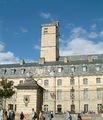 Philippe le Bon Tower |
 Philippe II Le Hardi's tomb |
 Dijon Cathedral |
Saint-Michel Church |
 The Market in Dijon designed by Alexandre Gustave Eiffel (who also designed the Eiffel Tower) |
La Chouette ("The Owl") at Notre Dame de Dijon (rub it for goodluck) |
|
Place Darcy during a light snow |
International relations
Twin towns - sister cities
Dijon is twinned with:
References
Notes
- ↑ Ville de Dijon. "Dijon". Dijon.fr. http://www.dijon.fr/fiche/150-800-habitants-a-dijon.art.1146.php. Retrieved 2009-05-05.
- ↑ "SAS - Special Air Service - WWII". Sasregiment.org.uk. http://www.sasregiment.org.uk/ww2.html. Retrieved 2009-05-05.
- ↑ "Railway Gazette: Pioneering PPP energises Dijon tram". http://www.railwaygazette.com/news/single-view/view/10/pioneering-ppp-energises-dijon-tram.html. Retrieved 2010-07-22.
- ↑ "SCADPlus: Protection of Geographical Indications and Designations of Origin". Europa.eu. http://europa.eu/scadplus/leg/en/lvb/l66044.htm. Retrieved 2009-05-05.
- ↑ Bazin, Jean-François, Le Tout Dijon, 2003, ISBN 2-913835-45-7
- ↑ "Opole Official Website - Twin Towns".
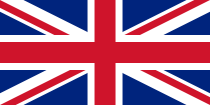
 (in English and Polish) © 2007-2009 Urząd Miasta Opola. http://www.opole.pl/miasto/index.php?option=com_content&task=blogcategory&id=20&Itemid=108. Retrieved 2009-06-18.
(in English and Polish) © 2007-2009 Urząd Miasta Opola. http://www.opole.pl/miasto/index.php?option=com_content&task=blogcategory&id=20&Itemid=108. Retrieved 2009-06-18. - ↑ "Official portal of City of Skopje - Skopje Sister Cities". © 2006-2009 City of Skopje. http://www.skopje.gov.mk/EN/DesktopDefault.aspx?tabindex=0&tabid=69. Retrieved 2009-07-14.
- ↑ Friendly relationship at Official website of Volgograd
- ↑ "VISIT VOLGOGRAD - RUSSIA - WELCOME TO THE CITY - THE HERO VOLGOGRAD!". www.visitvolgograd.info. http://www.visitvolgograd.info/Vennskapsbyer.htm. Retrieved 2010-01-05.
External links
- Official Dijon website
- Dijon tourism website
- Dijon travel guide from Wikitravel
- A lot of photos about Dijon
- Official site of the city government
- Photos of Dijon
- Old Postal Cards about Dijon
- Dijon in 1900
|
||||||||
|
|||||